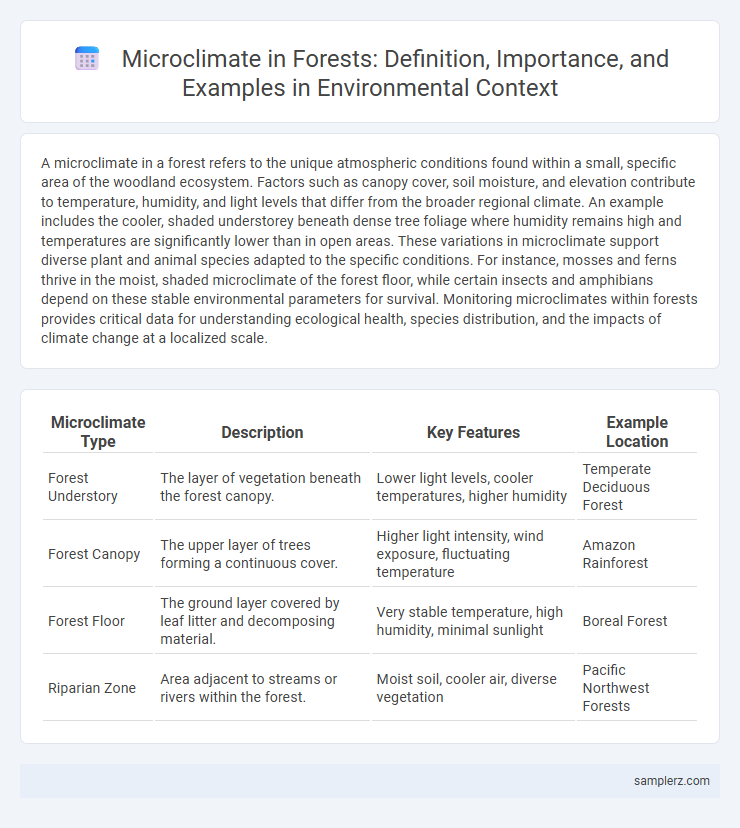A microclimate in a forest refers to the unique atmospheric conditions found within a small, specific area of the woodland ecosystem. Factors such as canopy cover, soil moisture, and elevation contribute to temperature, humidity, and light levels that differ from the broader regional climate. An example includes the cooler, shaded understorey beneath dense tree foliage where humidity remains high and temperatures are significantly lower than in open areas. These variations in microclimate support diverse plant and animal species adapted to the specific conditions. For instance, mosses and ferns thrive in the moist, shaded microclimate of the forest floor, while certain insects and amphibians depend on these stable environmental parameters for survival. Monitoring microclimates within forests provides critical data for understanding ecological health, species distribution, and the impacts of climate change at a localized scale.
Table of Comparison
| Microclimate Type | Description | Key Features | Example Location |
|---|---|---|---|
| Forest Understory | The layer of vegetation beneath the forest canopy. | Lower light levels, cooler temperatures, higher humidity | Temperate Deciduous Forest |
| Forest Canopy | The upper layer of trees forming a continuous cover. | Higher light intensity, wind exposure, fluctuating temperature | Amazon Rainforest |
| Forest Floor | The ground layer covered by leaf litter and decomposing material. | Very stable temperature, high humidity, minimal sunlight | Boreal Forest |
| Riparian Zone | Area adjacent to streams or rivers within the forest. | Moist soil, cooler air, diverse vegetation | Pacific Northwest Forests |
Defining Microclimates: Forest Ecosystem Perspectives
Microclimates in forest ecosystems exhibit distinct temperature, humidity, and light conditions influenced by canopy cover, understory vegetation, and soil composition. For example, shaded areas beneath dense tree canopies often maintain cooler temperatures and higher humidity compared to open forest gaps, supporting diverse flora and fauna adapted to these specific conditions. These microclimatic variations play a crucial role in regulating nutrient cycling, species distribution, and overall forest health.
Canopy Layers and Temperature Variation
Canopy layers in forests create distinct microclimates by regulating temperature variation through shading and airflow modulation. The upper canopy absorbs sunlight, reducing temperature extremes below, while the understory maintains cooler, stable conditions essential for diverse flora and fauna. This stratification influences local humidity and temperature gradients, contributing to biodiversity and ecosystem resilience.
Understory Moisture: Hidden Microclimate Zones
Understory moisture in forest microclimates creates hidden zones that sustain unique plant and animal species. These areas maintain higher humidity levels and cooler temperatures compared to the forest canopy, influencing nutrient cycling and seedling growth. Such microclimate variations play a critical role in forest biodiversity and ecological stability.
Impact of Forest Gaps on Sunlight Penetration
Forest gaps create microclimates by allowing increased sunlight penetration, which raises ground temperature and enhances photosynthesis for understory plants. These openings influence humidity and soil moisture levels, promoting biodiversity and accelerating nutrient cycling. The altered light regimes support growth of shade-intolerant species, driving forest succession and ecosystem dynamics.
Edge Effects: Microclimates at Forest Boundaries
Forest edges create unique microclimates characterized by increased sunlight, wind exposure, and temperature fluctuations compared to the forest interior. These edge effects influence humidity levels, soil moisture, and species composition, impacting biodiversity and ecological processes. Understanding microclimates at forest boundaries is crucial for habitat management and conservation strategies in fragmented landscapes.
Streamside Microclimates within Woodland Areas
Streamside microclimates within woodland areas create unique environmental conditions characterized by higher humidity and lower temperatures compared to surrounding forest interiors. These microclimates support diverse plant and animal species adapted to moist, shaded habitats and influence nutrient cycling and soil composition. Riparian vegetation along streams plays a crucial role in stabilizing banks, regulating water temperature, and enhancing overall ecosystem resilience.
Influence of Fallen Logs and Decomposition Sites
Fallen logs and decomposition sites significantly shape the microclimate within forest ecosystems by retaining moisture and regulating temperature fluctuations. These organic structures create localized humidity and cooler conditions, promoting biodiversity and soil nutrient cycling. The presence of decaying wood enhances habitat complexity, supporting fungi, insects, and small mammals adapted to these unique environmental niches.
Epiphytic Microhabitats: Mosses and Lichens in Forests
Epiphytic microhabitats, such as mosses and lichens, create unique microclimates on tree trunks and branches in forest ecosystems by maintaining higher humidity and lower temperature fluctuations compared to the surrounding air. These organisms contribute to biodiversity by providing habitat and moisture for various invertebrates and microorganisms. Their presence is vital for nutrient cycling and sustaining the microhabitat's ecological balance within temperate and tropical forests.
Microclimates Created by Leaf Litter Layers
Leaf litter layers in forest ecosystems create distinct microclimates by regulating soil temperature and moisture levels, enhancing nutrient cycling and supporting diverse microbial communities. These microenvironments buffer extreme weather conditions, maintaining humidity and providing habitat for invertebrates and seedlings. The insulating properties of leaf litter contribute to forest floor stability, influencing plant growth and biodiversity within the microclimate.
Wildlife-driven Microclimate Alterations in Forests
Wildlife-driven microclimate alterations in forests occur through activities such as beaver dam construction, which creates aquatic habitats that moderate temperature and humidity levels. Large mammals like elephants impact microclimates by knocking down trees, opening the canopy and increasing sunlight penetration that warms the forest floor. Burrowing animals such as prairie dogs aerate soil and influence moisture retention, thereby modifying the local temperature and humidity conditions within forest ecosystems.

example of microclimate in forest Infographic
 samplerz.com
samplerz.com